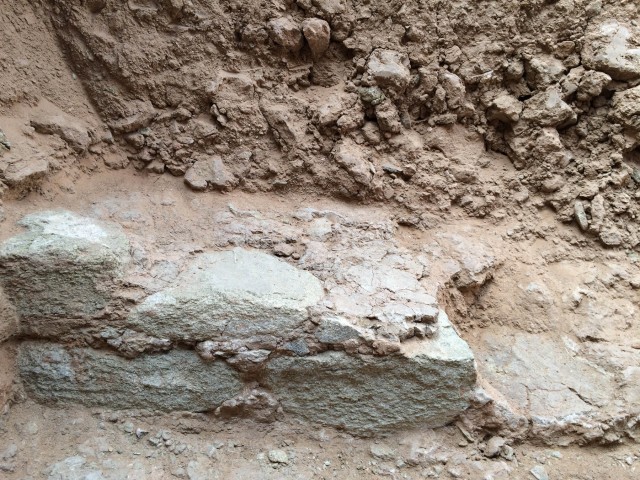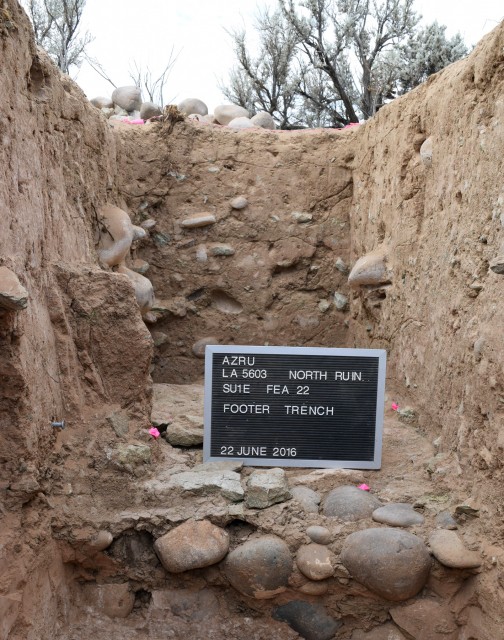- Home
- >
- Preservation Archaeology Blog
- >
- Notes from a Field Season at Aztec North
Michelle Turner, PhD Student, Binghamton University Department of Anthropology
(October 24, 2016)—The first time I heard about Aztec North was in the summer of 2013. I was a field intern at Crow Canyon, having just finished my first year of graduate school. One day, Shanna Diederichs took us all on a field trip to Aztec Ruins National Monument in northern New Mexico. I’d been there before, and done a field school nearby, so I knew all about Aztec West and its less-well-known neighbor, Aztec East.
But then Shanna mentioned that there was a third, unexcavated great house up on top of the river terrace, out of sight from where we stood. She told us that it might be the oldest great house at Aztec Ruins, and that it was built of adobe rather than the stone masonry we were seeing at Aztec West. And that this was about all anyone knew about it. I remember wondering how this great house could be so mysterious when it was just uphill from one of the best-known, most fully excavated Ancient Pueblo sites.
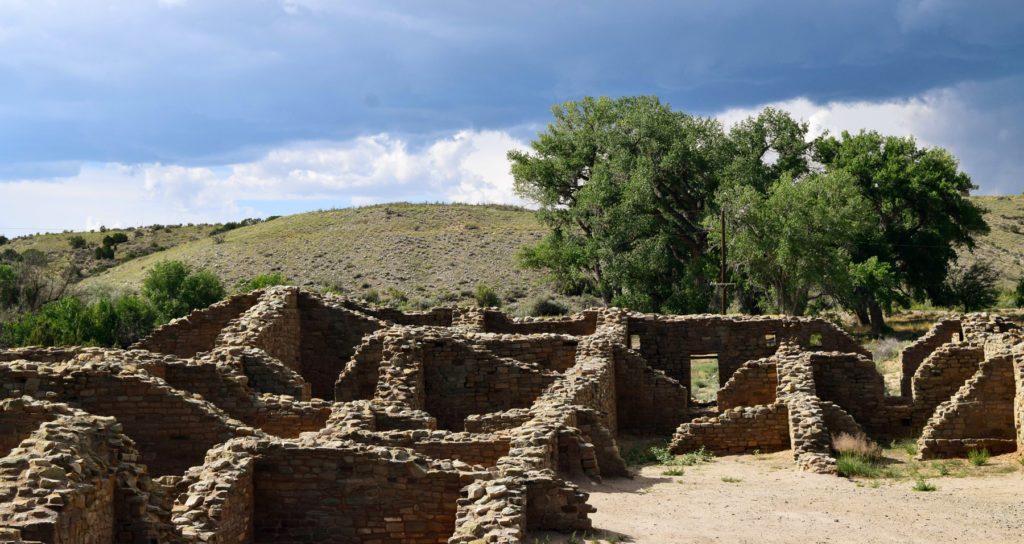
The next time I heard Aztec North mentioned was a few weeks later, when my advisor Ruth Van Dyke said there might be an opportunity for me to work with Aztec Ruins archaeologist Lori Reed to analyze surface ceramics from Aztec North. Ruth had also been talking to park staff about the possibility of doing some subsurface testing in the future, for my dissertation project. Sure enough, the next summer, those surface ceramics became the basis for my Master’s thesis.
About that time, Ruth and I started a year-and-a-half-long process of formally proposing subsurface testing of Aztec North. I was never very confident that we would actually get permission to do the work, but we wrote and rewrote our proposal, submitted it to several levels of peer review and National Park Service review, flew out for a tribal consultation meeting, and applied for four fieldwork grants.
And then one day last spring, everything came together. We had a permit, we had grant funding, and I’d passed my comprehensive exams and was ready to start a dissertation. All of a sudden I was figuring out how to house and feed and transport a crew of archaeologists for a month. I was buying buckets and railroad spikes and water coolers. With Ruth and a crew of eight archaeologist friends who volunteered their time and their invaluable expertise, we spent the month of June 2016 excavating a late Chaco period outlier great house.
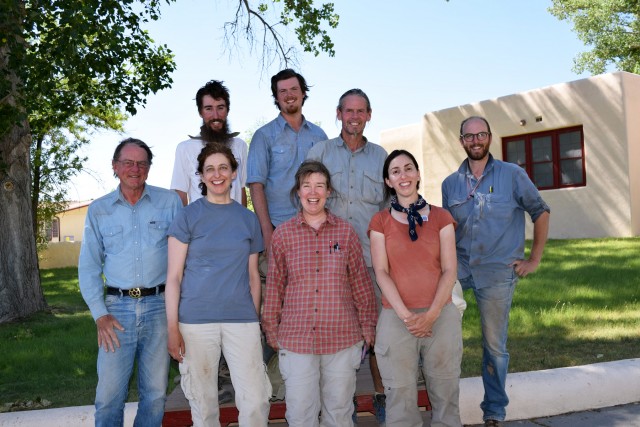
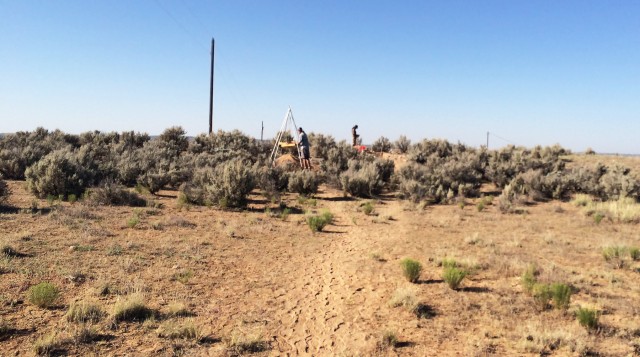
The biggest surprises were architectural. Many things about Aztec North look very Chacoan—its size, its D shape, its orientation. But before we put a shovel in the ground, one of the most striking things we noted about Aztec North was the near-absence of the sandstone you normally see at Chacoan great houses. So we expected to mainly find the local style of construction with river cobbles and adobe—a copy of a Chacoan great house, but one that would have required less labor.
Yet as we excavated through roof- and wall-fall, we encountered a lot of sandstone. It was crumbly, exfoliating green sandstone that sometimes turned to dust in our screens, but it had been shaped, and it seemed to have once been stacked. We soon realized we might be looking at the remains of a veneer.
Meanwhile, though, we were down a meter or more in our roof- and wall-fall and not finding anything like real walls. We reached nice smooth floors, and it became evident that the great house was just one story (at least where we were working), but we still couldn’t see exactly where the walls were. And then we went under the floors, and all became clear.
We found nearly meter-wide wall footer trenches with cobbles laid in hard mortar—serious foundations for serious great house walls. And around this time, we also uncovered small portions of coursed masonry, the remnants of core-and-veneer walls. The veneers were built of the green sandstone we’d been pulling out of wall-fall. But instead of the stone rubble core used at Aztec West or at great houses in Chaco, this core was cobble-reinforced adobe—mostly just handfuls of mud plopped into the space between the veneers. In the end, there are some things (like the core-and-veneer construction, those cobble footers, and the size of the rooms) that look very typically Chacoan, while other elements (like all the adobe and the mediocre veneers) look more local.
|
|
Compared to other sites of this period, there were not a lot of artifacts. But we do have a nice dissertation-sized assemblage that includes some very significant finds. One day while screening soil from a floor near a charcoal feature, I pulled out five little vertebrae I immediately knew were weird. Our zooarchaeologist Dr. Lubna Omar confirmed that they were fish. It has long been thought that Ancient Pueblo people did not eat fish, so this was important. We also had a surprising amount of obsidian, which suggests trade relations with the Jemez region. We will be analyzing these and our many other artifacts in the coming months, and we are applying for more grant funding to radiocarbon date our corncobs and other organic samples in the hopes of more firmly establishing dates for when people were using the site.
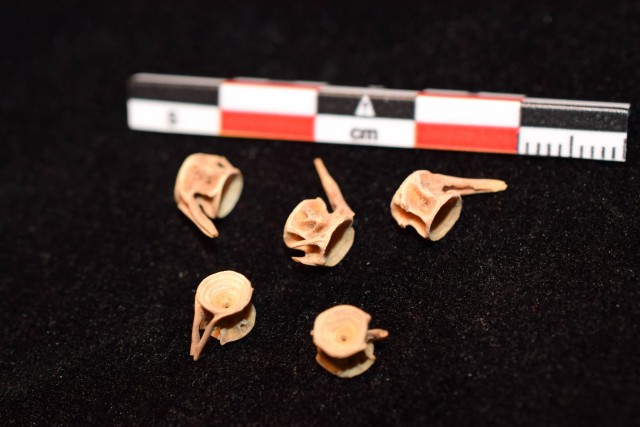

The relatively small number of artifacts raises some important new questions about the site. It seems that, despite the size of the great house and the work that went into it, people didn’t use it for very long or very intensively. And yet, we found architectural evidence suggesting it was renovated. Some period of time after the original construction, people seem to have knocked down the original back wall of the great house and built a new one. Why renovate a building they were barely using?
This might have to do with Aztec North’s place in a greater cultural landscape. The three great houses, two in the valley and the one centered between them up above, are clearly sited as part of a symmetrical whole, and Ruth has argued for many years that they seem to be recreating the spatial relationship between Pueblo Bonito, Chetro Ketl and Pueblo Alto at Chaco Canyon. So maybe Aztec North’s symbolism, as the great house in a high place, as a new Pueblo Alto, was more important than its actual usefulness as a building. As we continue our analysis over the coming months, my hope is that our data will contribute not just to understanding this building, but also to understanding of the local social landscape and how Aztec related to the greater Chacoan world.
Acknowledgments: Funding for this project was provided by grants from the Arizona Archaeological and Historical Society, the Western National Parks Association, the Explorers Club Exploration Fund – Mamont Scholars Program, and the Lewis and Clark Fund for Exploration and Field Research. We are also grateful for the support of Aztec Ruins National Monument and its staff, including Larry Turk, Aron Adams, Lori Reed, Stephen Matt, Jeffery Wharton, and Vern Hensler.
Recommended reading:
Brown, Gary M. and Cheryl I. Paddock
2011 Chacoan and Vernacular Architecture at Aztec Ruins: Putting Chaco in its Place. Kiva 77(2):203–224.
Lekson, Stephen H.
2015 The Chaco Meridian: One Thousand Years of Political and Religious Power in the Ancient Southwest. 2nd ed. Rowman & Littlefield, Lanham, Maryland.
Reed, Paul, ed.
2008 Chaco’s Northern Prodigies: Salmon, Aztec, and the Ascendancy of the Middle San Juan Region after AD 1100. University of Utah Press, Salt Lake City.
Stein, John R. and Peter J. McKenna
1988 An Archaeological Reconnaissance of a Late Bonito Phase Occupation Near Aztec Ruins National Monument, New Mexico. National Park Service, Santa Fe.
Van Dyke, Ruth M.
2007 The Chaco Experience: Landscape and Ideology at the Center Place. School for Advanced Research Press, Santa Fe.
Explore the News
-
Join Today
Keep up with the latest discoveries in southwestern archaeology. Join today, and receive Archaeology Southwest Magazine, among other member benefits.
